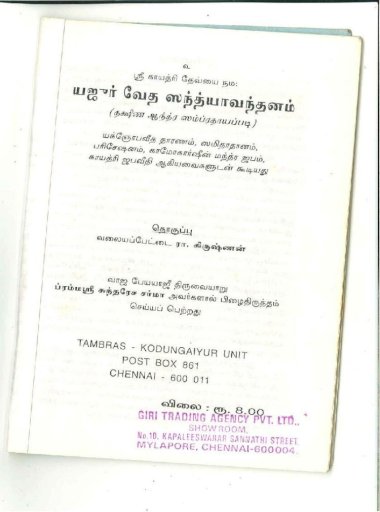

A devotee, Rama Sastri, was entrusted with the task of personally carrying the Acharya's letter carrying the naming of his successor to the Peetham to Krishnaraja Wodeyar, Maharaja of Mysore. In 1912, Acharya Sacchidananda Shivabhinava Narasimha Bharati Swaminah decided to name Narasimha Sastri as his successor to the Sharada Peetham.
SANDHYAVANDANAM TELUGU EN FREE
He spent his free time in the peaceful environs of the Gavigangadhareshwara Temple in Gavipuram, Bangalore. Even in Bangalore there was no change in Narasimha's inwardness. Mahamahopadhyaya Virupaksha Sastri taught him Vedanta. Mahamahopadhyaya Vellore Subrahmanya Sastri and Mimamsa Shiromani Vaidyanatha Sastri taught him Purva Mimamsa by texts such as the Bhatta Dipika. Narasimha Sastri moved to Bangalore in 1911 with his parents and plunged into his studies. Narasimha Sastri was chosen to be a disciple at that institution. The then Acharya of the Sringeri Matha had established in 1910 an institution of higher Vedantic training- Bharatiya Girvana Prouda Vidya Vardhini Shala in Bangalore. The Swami kept a close watch over the progress of his ward. Narasimha, after his twelfth year, changed over to Sadvidya Sanjivini Pathasala in Sringeri under the express wishes of Sri Sacchidananda Shivabhinava Narasimha Bharati Swaminah, the then head of the matha. He was regular in the performance of Sandhyavandanam three times a day, and Agnikarya, twice a day.

His Brahmopadesha was performed when he was eight. He was then sent to the local Anglo-vernacular school run by the government. His parents performed the Choodakarma (a rite performed as one of the sixteen saṃskāras that enables one to go to school). He was lodged in the house of Srikanta Sastri, the then administrator of the Sringeri Matha. He was an introvert and had little attraction for the objects of the world. The childhood days of Narasimha Sastri (as he was named by his parents) were passed in Sringeri. A notable feature of his life was that his birth, upanayanam, sannyasa and videha mukti (death), all happened on Sundays. He was the last of 12 children born to this couple and the only one who survived past infancy. His father was Gopala Sastri and mother, Lakshmamma. 1.5 Avadhuta Sthiti and naming his successorĬhandrashekhara Bharati Swaminah was born to pious parents in Sringeri on Ashvayuja Shukla Ekadashi (the eleventh day of the bright fortnight in the month of Ashwayuja) in the Hindu lunar year Nandana (corresponding to October 16, 1892).He was known to be a Jivanmukta ( Sanskrit for one liberated while alive). He was one of the most significant spiritual figures in Hinduism during the 20th century. Chandrashekara Bharathi III (1892–1954), born Narasimha Shastri, was the Jagadguru (literally, teacher of the world, in Sanskrit assigned to heads of Hindu mathas) of the Sringeri Sharada Peetham during 1912–1954.


 0 kommentar(er)
0 kommentar(er)
